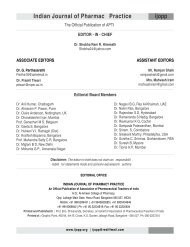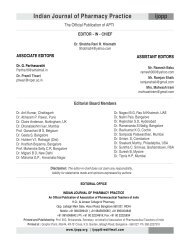APTI ijopp - Indian Journal of Pharmacy Practice
APTI ijopp - Indian Journal of Pharmacy Practice
APTI ijopp - Indian Journal of Pharmacy Practice
- No tags were found...
You also want an ePaper? Increase the reach of your titles
YUMPU automatically turns print PDFs into web optimized ePapers that Google loves.
<strong>Indian</strong> J. Pharm. Pract. 1(2), Jan-Mar, 2009<strong>APTI</strong>AbstractBoth macrolides as well as cephalosporins are widely used in the treatment <strong>of</strong> various lower respiratory tractinfections either alone or in combination. The most commonly prescribed macrolide is azithromycin, generally incombination with different cephalosporins. The objectives <strong>of</strong> the present study were to find out the differentcombinations <strong>of</strong> azithromycin and cephalosporins generally prescribed, compare their efficacy, safety (adverse drugreactions) and cost. A prospective study was conducted in the medicine ward at St. Martha's Hospital, Bangalore.The data was analyzed to interpret different parameters <strong>of</strong> the study. Efficacy was determined based upon the clinicalresponse (reduction in symptoms) and length <strong>of</strong> hospital stay. Safety was determined by assessing the occurrence <strong>of</strong>ADR and their severity. Cost <strong>of</strong> treatment was calculated by cost effective analysis. In the study period, 88 patientswere included based on the inclusion criteria. Results revealed that different combinations prescribed wereazithromycin + cefotaxime, azithromycin + ceftriaxone and azithromycin + cefuroxime. The most commonlyprescribed combination was found to be cefotaxime with azithromycin. The cefotaxime group showed statisticallysignificant difference in the reduction <strong>of</strong> clinical symptoms thereby indicating greater efficacy. 18% <strong>of</strong> the patientsexperienced ADRs which were mild in nature with none severe indicating that all the combinations were safe. Thecost effective analysis showed that combination <strong>of</strong> azithromyin and cefotaxime is most economical.Key words: Antibiotics, Organisms, Antibiotic use, PediatricsINTRODUCTIONRespiratory tract infections (RTI) are very common in the budgets. In most <strong>of</strong> the adults with LRTI, the illness iscommunity and are one <strong>of</strong> the major reasons for visiting self-limiting and its course will not be modified by1to primary care physicians . The broad diagnosis <strong>of</strong> RTI antibiotic therapy, representing viral or clinically nonincludesthe two principal sub-diagnoses <strong>of</strong> lowerrelevant bacterial diseases. However, failure to initiaterespiratory tract infection (LRTI) and upper respiratoryantibiotic therapy within four hours in cases <strong>of</strong>2tract infection (URTI) . Community-acquired lowercommunity acquired pneumonia is already associatedrespiratory tract infection is a common cause <strong>of</strong> acute6with an increased mortality. The major problem in theillness in adults. The spectrum <strong>of</strong> disease ranges frommild mucosal colonization or infection, to acutemanagement <strong>of</strong> the LRTI is the inability to determine the7bronchitis or acute exacerbation <strong>of</strong> chronic bronchitis causative micro-organism in majority <strong>of</strong> patients .(AECB) or chronic obstructive pulmonary disease There are great systematic differences in the prescription(COPD), to overwhelming parenchymal infection in <strong>of</strong> antibiotics, both overall and for LRTI, between3patients with community-acquired pneumonia (CAP) . countries and between different healthcare providers in8The term LRTI includes a wide range <strong>of</strong> diseases which the same country . The "first generation" <strong>of</strong> guidelineshave different underlying pathologies and etiologies, e.g. was mostly consensus-based, whereas those published in4, 5acute bronchitis and pneumonia . In the out-patient 2000/2001 are at least partly evidence-based. However,setting, LRTI account for the majority <strong>of</strong> all antibiotics there is still a lack <strong>of</strong> evidence in many areas <strong>of</strong> the LRTIp r e s c r i b e d , b u r d e n i n g h e a l t h c a r e d r u g field, and, in addition, interpretation <strong>of</strong> the available<strong>Indian</strong> <strong>Journal</strong> <strong>of</strong> <strong>Pharmacy</strong> <strong>Practice</strong>Received on 05/02/2009 Modified on 13/03/2009Accepted on 16/03/2009 © <strong>APTI</strong> All rights reserved<strong>ijopp</strong>Efficacy and Safety <strong>of</strong> Azithromycin with Various CephalosporinsUsed in Treatment <strong>of</strong> Lower Respiratory Tract Infection1 2 3Imran Ahmad Khan , Shobha Rani. R.H , Geetha Subramanyam1. Sr. DSA, Quintiles, Bangalore2. Department <strong>of</strong> <strong>Pharmacy</strong> practice, Al-Ameen college <strong>of</strong> <strong>Pharmacy</strong>, Bangalore-5600273. Dept. <strong>of</strong> Medicine, St. Martha’s Hospital, Bangalore*Address for correspondence: iamkhan@quintiles.com9evidence is variable in some cases .MATERIALS AND METHODSThe present study was conducted at medicine wards <strong>of</strong>St. Martha's Hospital, Bangalore which is 850 bedded53
















